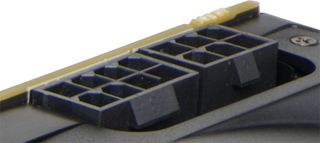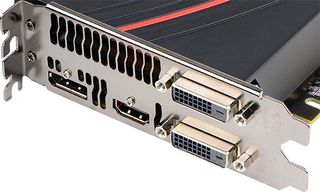Radeon R9 290X Review: AMD's Back In Ultra-High-End Gaming
After eight months of watching Nvidia go uncontested in the ultra-high-end graphics market, AMD has a new GPU based on existing technology that promises to challenge the top position. It gets mighty loud at times, but you can't ignore the R9 290X's price.
The Radeon R9 290X
AMD’s reference Radeon R9 290X is exactly as long as Radeon HD 7970 (11”) and similarly two expansion slots wide. Even the 75 mm centrifugal fan looks like it carried straight over.

Also familiar is the little switch on the card’s top edge. Previously, that might have been used to control maximum clock rates, enabling a minor boost for an extra bit of performance. Given those PowerTune changes we just covered, though, that wouldn't make sense. Instead, that's the switch to toggle between Quiet and Uber mode.

The fan shroud is clearly updated, and I’ve already heard feedback from Tom’s Hardware staffers who really like the more sweeping red and black design. I remain partial to Nvidia’s metal shroud and polycarbonate window though, particularly at this very high-end price point. There are plenty of GeForce GTX 780s with third-party coolers, but a great many ship with the reference ID I wrote about in The Story Of How GeForce GTX 690 And Titan Came To Be. It’d be great to see AMD step up with something similarly inspired.

Despite similar dimensions, Radeon R9 290X is clearly based on a different PCB than AMD’s Tahiti-based cards. Most obvious is the lack of CrossFire connectors. Because Hawaii features an xDMA engine, CrossFire traffic is carried over the PCI Express bus, eliminating the need for those pesky cables. It appears improbable that an aftermarket cooler designed for 7970 would work on R9 290X.

AMD is staying quiet on maximum board power, but claims that R9 290X should push up to 250 W in typical gaming scenarios. Realistically, because PowerTune is constantly making changes, it’s pretty difficult to nail down peak consumption. We recorded a range, though, and found a peak that spanned from 225 to 295 W. Given one eight- and one six-pin auxiliary power connector, plus a 75 W PCI Express slot, those numbers are within the 300 W you probably wouldn’t want to exceed.

The R9 290X cards we received all had two dual-link DVI ports, a full-sized HDMI output, and one DisplayPort connector. Its Hawaii GPU features an updated display controller though, which includes a third independent timing generator. So, although the flagship board comes equipped with one less display output than the R9 280X we recently reviewed, you can actually hook up six screens operating at different resolutions and timings to the R9 290X with an MST hub.
Hawaii’s new display controller will also enable the 600 MHz pixel rates needed to support upcoming single-stream Ultra HD displays at 60 Hz. As you know, currently, the only way to drive a 4K screen is through two HDMI ports or one DisplayPort 1.2 output with MST support. These correspond to a pair of 1920x2160 tiles that come together as a 2x1 Eyefinity array. Next-generation scalars will make 3840x2160p60 possible without tiling—they’ll simply require higher pixel clocks. Radeon R9 290X can do it for sure, but AMD isn’t certain whether its older display controllers will.
Stay on the Cutting Edge
Join the experts who read Tom's Hardware for the inside track on enthusiast PC tech news — and have for over 25 years. We'll send breaking news and in-depth reviews of CPUs, GPUs, AI, maker hardware and more straight to your inbox.
Current page: The Radeon R9 290X
Prev Page Overclocking: PowerTune Changes Things Next Page Test System And Benchmarks-
beta212 That's incredible. Especially at high res, I wonder how they do it. But the low price alone is enough to blow the competition away. Seriously think about it, it's around half the price for higher performance!Reply
- AMD: We're not aiming for the ultra high end.
I think Nvidia just got trolled. -
slomo4sho Great price point. This card has already broken world records just a few hours after release!Reply
-
esrever 2 of these for 4k looks amazing but Im a little disappointed by the power consumption when you crank up performance.Reply -
aznguy0028 I was thinking about hopping on the 7970ghz when it's on sale, but after seeing this, it's time to break apart the piggy bank for the 290x, what value!Reply -
Benthon Like the conclusion said, you just can't argue about aesthetics and thermals at this price point/performance. Well done AMD, lets see team green's response! Go consumer!Reply -
Shankovich Wow, and it's pegged at 73% too. Even if nVidia's "780ti" beats the 290X, it probably won't beat a 290X running at full power. And if mantle does make some big performance boosts, nVidia is going to be in a really tight spot. Looking forward to what they'll do. In the mean time, loving this competition! We all win in the end.Reply -
anxiousinfusion Wait the 290 X... X? is going to be $550?! Forgive me, padre for I have sinned.Reply
Most Popular

